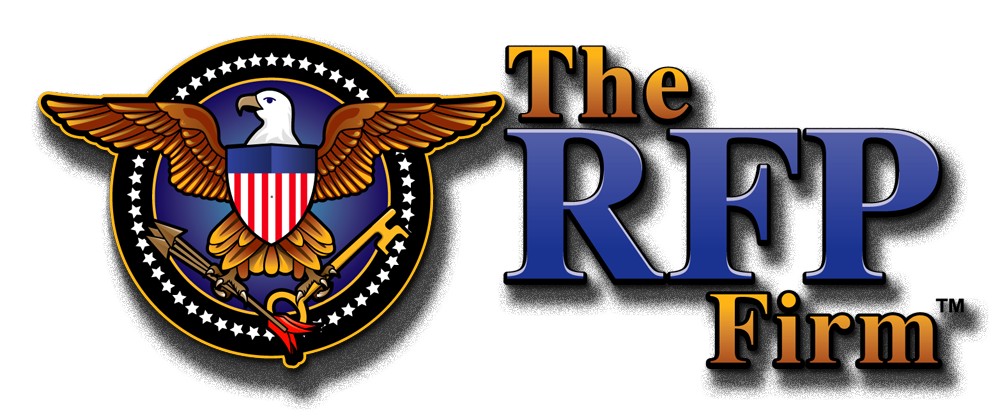Blog
Government & Commercial Proposal Writing Services
 The RFP Firm is expert at writing proposals in Response to Federal and State Government RFP Solicitations that will give you a Competitive Advantage over your competition.
The RFP Firm is expert at writing proposals in Response to Federal and State Government RFP Solicitations that will give you a Competitive Advantage over your competition.


Proposal Writing Services , RFP Proposal Consulting, Government RFP writing
Government RFP Proposal Writing Services
Government & Commercial Proposal Writing Services
 The RFP Firm is expert at writing proposals in Response to Federal and State Government RFP Solicitations that will give you a Competitive Advantage over your competition.
The RFP Firm is expert at writing proposals in Response to Federal and State Government RFP Solicitations that will give you a Competitive Advantage over your competition.

In order to support the operations, goals, and objectives of a government agency, federal contracts are provided to commercial entities to perform a wide variety of services. Being a government agency or department, they come with a large number of rules and regulations requiring numerous form, agreement, authorizations, and contingencies.
Federal government proposals are basic government contracts, grant, or agreements that enable the government to fund various projects or research and are subject to strict terms and conditions supported by specific payment terms, reporting requirements, and responsibility initiatives. Often these contracts require a performance bond as a guarantee that the contractor will deliver the services requested. If the contractor defaults on the contract, the government has recourse by cashing in on the performance bond, taking civil action, or even criminal actions if appropriate, all resulting in negative financial consequences to the contractor that doesn’t fulfill its agreed upon obligations.
The rules and regulations must be diligently followed at the federal, state, and local government levels and the consequences can be serious based on some very complex statutes. Even during the request for federal government proposals and the requirements for submitting a response, these regulatory and statutory provisions can be a bit complex. Contractors must pay attention to the government’s procedures and methodology used to solicit the contract, the process for negotiating the contract, specific reimbursable costs, and how the contractor must submit its invoices in order to get paid.
Often signed forms must be included with the proposal such as minimum wage acknowledgement, conflict of interest, subcontracting, drug-free workplace, and affirmative action. While the government agencies have tried to reduce the burden of all of their rules and regulations, prospective government contractors need to be sure that they are one hundred percent compliant with the government proposal requirements.
There are several different types of federal government contracts and preparing your proposal should take these into account. There is a standard contract although you’ll find that there are a slew of clauses that often seem to go on and on. There are master task order contracts (MATOC) where you are approved under a master contract and then receive task orders periodically over time. There is an indefinite delivery indefinite quantity (IDIQ) where the approved services are known, but the amount of each is not necessarily know. There are also straight order contracts for specific or various supplies.
Now to the good part. There are great opportunities for various types of small businesses looking to pursue government contracts! In fact, the US Government purchases around $200 Billion in goods and services annually. Much of this is operations & maintenance, security, rehabilitation & construction of government facilities while others are purchases of various goods, equipment, and supplies needed to operate these facilities. Then, of course, there are numerous types of vehicles from autos, trucks, and military vehicles to planes, drones, and spacecraft. In addition, we have medical research and funding of new technologies.
For small businesses, every agency has either specific percentages of their contracts designated to meet either specific goals or percentages of their contract investments. The primary “set-aside” RFPs resulting in federal government proposals are for Small Business Enterprise, Minority-Owned Business, Small Disadvantaged Business, Women-Owned Business, HUBZone, Veteran-Owned Business, and Disabled Veteran-Owned Business designations.
Often, when first getting into federal government contracting, a small business doesn’t have the experience (Past Performance) required or at least desired by the agency that issued the RFP. Past Performance provides the government with the confidence that your company has successfully fulfilled similar contracts. One way to begin to get this experience is to provide services as a subcontractor to a larger government contractor who is looking for small businesses to participate in the contract in order to meet the governments small business goals. Once you have provided services as a legitimate subcontractor, you can use that experience as evidence of your Past Performance on a federal contract when bidding on up and coming contracts as a Prime contractor.
As a small business, there are a few things you can begin to do to prepare for before submitting proposals in response to federal government RFPs. First, get your company certified in one or more categories of small business as mentioned above by contacting the Small Business Administration (SBA) to see in what categories you may qualify. Next, you’ll need a DUNS number (Dun & Bradstreet), now called a Unique Entity Identifier in many government solicitations. With a DUNS number, you’ll be able to register in the federal government’s System for Award Management (SAM) where you’ll document all of that information and receive a CAGE Code making life much easier when bidding on these types of contracts.
If necessary, there are attorneys and consultants who specialize in helping companies through this process, but I recommend attempting to do this yourself first as the items in the previous paragraph are not that complicated to do yourself and will save you a lot of money. Even so, there may be issued where the advice of an expert can make this process more efficient.